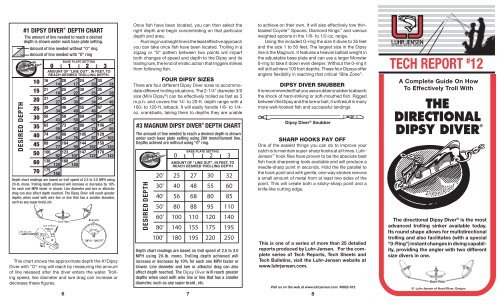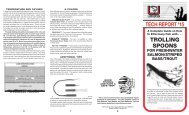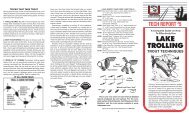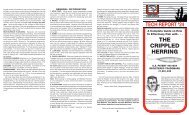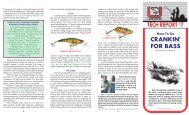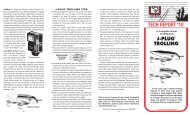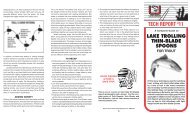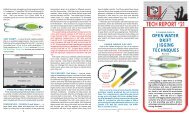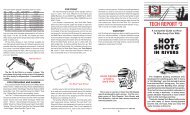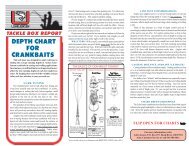Dipsy Diver Depth Chart and Information - UPangler
Dipsy Diver Depth Chart and Information - UPangler
Dipsy Diver Depth Chart and Information - UPangler
Create successful ePaper yourself
Turn your PDF publications into a flip-book with our unique Google optimized e-Paper software.
This chart shows the approximate depth the #1<strong>Dipsy</strong><br />
<strong>Diver</strong> with "O"-ring will reach by measuring the amount<br />
of line released after the diver enters the water. Trolling<br />
speed, line diameter <strong>and</strong> lure drag can increase or<br />
decrease these figures.<br />
6<br />
Once fish have been located, you can then select the<br />
right depth <strong>and</strong> begin concentrating on that particular<br />
depth <strong>and</strong> area.<br />
Running in a straight line is the least effective approach<br />
you can take once fish have been located. Trolling in a<br />
zigzag or "S" pattern between two points will impart<br />
both changes of speed <strong>and</strong> depth to the <strong>Dipsy</strong> <strong>and</strong> its<br />
trailing lure, the kind of erratic action that triggers strikes<br />
from following fish.<br />
FOUR DIPSY SIZES<br />
There are four different <strong>Dipsy</strong> <strong>Diver</strong> sizes to accommodate<br />
different trolling situations. The 2-1/4" diameter 3/0<br />
size (Mini <strong>Dipsy</strong> ® ) can be effectively trolled as fast as 3<br />
m.p.h. <strong>and</strong> covers the 14- to 20-ft. depth range with a<br />
100- to 120-ft. letback. It will easily h<strong>and</strong>le 1/8- to 1/4-<br />
oz. crankbaits, taking them to depths they are unable<br />
#3 MAGNUM DIPSY DIVER ® DEPTH CHART<br />
The amount of line needed to reach a desired depth is shown<br />
under each base plate setting using 20# monofilament line.<br />
<strong>Depth</strong>s achived are without using “O” ring.<br />
DESIRED DEPTH<br />
BASE PLATE SETTING<br />
0 1 2 3<br />
AMOUNT OF "LINE OUT", IN FEET, TO<br />
REACH DESIRED TROLLING DEPTH<br />
20' 25 27 30 32<br />
30' 40 48 55 60<br />
40' 56 68 80 85<br />
50' 80 88 95 110<br />
60' 100 110 120 140<br />
80' 140 155 175 195<br />
100' 180 195 220 250<br />
<strong>Depth</strong> chart readings are based on troll speed of 2.5 to 3.0<br />
MPH using 20-lb. mono. Trolling depth achieved will<br />
increase or decrease by 10% for each one MPH faster or<br />
slower. Line diameter <strong>and</strong> lure or attractor drag can also<br />
affect depth reached. The <strong>Dipsy</strong> <strong>Diver</strong> will reach greater<br />
depths when used with wire line or line that has a smaller<br />
diameter, such as any super braid , etc.<br />
to achieve on their own. It will also effectively tow thinbladed<br />
Coyote Spoons, Diamond Kings <strong>and</strong> various<br />
weighted spoons in the 1/8- to 1/2-oz. range.<br />
Using the included O-ring the size 0 dives to 35 feet<br />
<strong>and</strong> the size 1 to 50 feet. The largest size in the <strong>Dipsy</strong><br />
line is the Magnum. It features a heavier ballast weight in<br />
the adjustable base plate <strong>and</strong> can use a larger Monster<br />
0-ring to take it down even deeper. Without the 0-ring it<br />
will still achieve 100 foot depths. These four <strong>Dipsy</strong>s offer<br />
anglers flexibility in reaching that critical “Bite Zone”.<br />
DIPSY DIVER SNUBBER<br />
It is recommended that you use a rubber snubber to absorb<br />
the shock of hard-striking or soft-mouthed fish. Rigged<br />
between the <strong>Dipsy</strong> <strong>and</strong> the lure or bait, it will result in many<br />
more well-hooked fish <strong>and</strong> successful l<strong>and</strong>ings.<br />
<strong>Dipsy</strong> <strong>Diver</strong> ® Snubber<br />
SHARP HOOKS PAY OFF<br />
One of the easiest things you can do to improve your<br />
catch is to maintain super-sharp hooks at all times. Luhr-<br />
Jensen hook files have proven to be the absolute best<br />
fish hook sharpening tools available <strong>and</strong> will produce a<br />
needle-sharp point in seconds. Hold the file parallel to<br />
the hook point <strong>and</strong> with gentle, one-way strokes remove<br />
a small amount of metal from at least two sides of the<br />
point. This will create both a sticky-sharp point <strong>and</strong> a<br />
knife-like cutting edge.<br />
This is one of a series of more than 25 detailed<br />
reports produced by Luhr-Jensen. For the complete<br />
series of Tech Reports, Tech Sheets <strong>and</strong><br />
Tech Bulletins, visit the Luhr-Jensen website at<br />
www.luhrjensen.com.<br />
Visit us on the web at www.luhrjensen.com #8822-012<br />
7 8<br />
TECH REPORT # 12<br />
A Complete Guide On How<br />
To Effectively Troll With<br />
THE<br />
DIRECTIONAL<br />
DIPSY DIVER<br />
The directional <strong>Dipsy</strong> <strong>Diver</strong> ® is the most<br />
advanced trolling sinker available today.<br />
Its round shape allows for multidirectional<br />
trolling <strong>and</strong> also facilitates (with a special<br />
"0-Ring") instant changes in diving capability,<br />
providing the angler with two different<br />
size divers in one.<br />
© Luhr-Jensen of Hood River, Oregon<br />
®<br />
12 <strong>Dipsy</strong>.indd 1 1/21/09 1:03:46 PM
Like all diving planers, the directional <strong>Dipsy</strong> <strong>Diver</strong> ® is held<br />
in planing position by a lead weight. But with the <strong>Dipsy</strong>,<br />
this weight is molded into an adjustable base plate. By<br />
rotating this plate to the right or left, the planing surface<br />
is offset, causing the diver to move to either the port or<br />
starboard side when trolled. By leaving the weight at<br />
center, the diver will track straight behind your boat.<br />
DIVERS VS. LEAD<br />
Lead weights are widely used to take a lure deep, but<br />
when compared with a diver (especially a multidirectional<br />
one) lead leaves much to be desired.<br />
Lead relies 100% on its inherent weight to overcome<br />
drag <strong>and</strong> achieve depth. <strong>Diver</strong>’s use only a fractional<br />
amount of lead, along with a planing surface, to achieve<br />
the same depth. When fishing lead the resistance of a<br />
heavy weight is constant, but a diver loses its resistance<br />
in the water when tripped, allowing easy retrieval of your<br />
gear. This loss of pressure <strong>and</strong> drag also provides extra<br />
sport <strong>and</strong> enjoyment when fighting fish, as there will be<br />
almost no terminal gear resistance. Perhaps even more<br />
important, because the diver pressure is relieved when<br />
tripped, fish are prevented from gaining leverage <strong>and</strong><br />
throwing your hook. Prior to divers, the only way an angler<br />
could accomplish this loss of water pressure was to use<br />
a break-away lead; a very expensive way to fish.<br />
Another big advantage of divers over lead weights<br />
is that divers also act as fish attractors because of their<br />
color <strong>and</strong> shape. When trolling or exploring unknown<br />
waters or where fish are scattered, divers provide an<br />
attraction value to draw fish in. <strong>Dipsy</strong> <strong>Diver</strong>s are available<br />
in an extensive array of colors, including Everglo <br />
Glow-In-The-Dark finishes.<br />
<strong>Diver</strong>s are very easy to operate, apply to trolling<br />
in both fresh <strong>and</strong> salt water <strong>and</strong> are simple to rig. Any<br />
angler can use a diver successfully the first time out<br />
<strong>and</strong> they only require a minimum of terminal gear <strong>and</strong><br />
storage space.<br />
HOW IT WORKS<br />
The special round shape <strong>and</strong> resulting multidirectional<br />
feature sets the <strong>Dipsy</strong> <strong>Diver</strong> apart from others. The<br />
ability of the angler to add or subtract depth capability<br />
with the unique "O-ring" (on sizes #0, #1 <strong>and</strong> #3) is yet<br />
another outst<strong>and</strong>ing feature of this diver...it’s like getting<br />
two separate divers for the price of one. Here’s how the<br />
<strong>Dipsy</strong> <strong>Diver</strong> works.<br />
After you’ve tied your line to the barrel swivel at the<br />
front end of the diver <strong>and</strong> have locked the adjustable<br />
trip mechanism in place, it’s ready to fish. When trolled,<br />
water pressure against the diver’s planing surface causes<br />
it to dive. Shifting the base plate weight to the left or<br />
right offsets the planing surface <strong>and</strong> results in the diver<br />
descending on a controllable angle. This multidirectional<br />
feature is possible because the base plate contains a<br />
molded-in weight that can be shifted in degrees. Each<br />
degree of shift will cause a change in the angle of descent.<br />
Set at “0” the diver will dive <strong>and</strong> track straight.<br />
A shift right or left as indicated on the base plate arrow<br />
(see diagram below) will cause the diver to track to port<br />
or to starboard.<br />
Because the <strong>Dipsy</strong> <strong>Diver</strong> is directional, it gives you the<br />
following advantages not obtainable with other divers<br />
or planers:<br />
• It doubles your trolling area, as indicated in the page 5<br />
illustration, <strong>and</strong> lures are thus exposed to fish which<br />
might not otherwise see them.<br />
• More lures can be trolled <strong>and</strong> sharp turns made without<br />
the fear of tangling.<br />
• Downrigger anglers particularly can take advantage<br />
of the <strong>Dipsy</strong> because it will troll to the side <strong>and</strong> not<br />
interfere with cables, allowing the use of more lines<br />
than previously possible.<br />
• It can be used for trolling just beneath the surface <strong>and</strong><br />
can be tripped easily from the boat.<br />
Size #0, #1 <strong>and</strong> #3 <strong>Dipsy</strong>s come with a special removable<br />
"O-ring" which, when in position, creates extra planing<br />
surface <strong>and</strong> delivers up to 20% more depth. The depth<br />
your diver attains will depend on trolling speed, diameter<br />
of line, length of line out <strong>and</strong> weight of your lure <strong>and</strong>/or<br />
added attractor such as a dodger. Light lines <strong>and</strong> small<br />
lures generate less water resistance <strong>and</strong> therefore more<br />
depth, while heavy lines <strong>and</strong> large lures <strong>and</strong>/or dodgers<br />
generate more resistance <strong>and</strong> comparably less depth. It<br />
also is important to note that the angle of your line from<br />
boat to water DOES NOT indicate the underwater position<br />
of the <strong>Dipsy</strong> <strong>Diver</strong>, because of line belly. The table on<br />
page 6 should be used to correctly figure the true side<br />
angle <strong>and</strong> location of the diver underwater.<br />
RIGGING<br />
Rig your <strong>Dipsy</strong> for fishing similarly to the page 5 diagrams,<br />
allowing at least 4- to 6-feet of leader between the diver<br />
<strong>and</strong> lure or, when using a dodger, have at least 48" of<br />
leader between it <strong>and</strong> the diver.<br />
Because the trip mechanism is adjustable, you’ll<br />
be able to set it just right for the gear you're using. The<br />
#1 tension screw should be set to hold the release pin<br />
securely in place while trolling, but release easily from a<br />
sharp tug on the rod or strike from a fish.<br />
The base plate is held in position by tension screw #2,<br />
which should be tightened just enough to hold the plate in<br />
position <strong>and</strong> still permit easy rotation for a new setting.<br />
Shown in the following illustrations are several ways<br />
to rig the <strong>Dipsy</strong> <strong>and</strong> trailing lures <strong>and</strong>/or dodgers for<br />
trolling. Note the best results with a dodger are obtained<br />
from base plate settings 0 to 2.<br />
TROLLING TIPS<br />
With trolling you can cover the greatest amount of water<br />
in the shortest time, allowing you to locate concentrations<br />
of fish quickly <strong>and</strong> easily, even on big or unknown<br />
waters. The multidirectional aspect of the <strong>Dipsy</strong> <strong>Diver</strong><br />
means that you can cover an extremely wide swath of<br />
water on each trolling pass <strong>and</strong> draw strikes from fish<br />
that otherwise would have been missed. Because the<br />
diver can be set to run at predetermined depths, you<br />
also have the ability to cover not only a wide horizontal<br />
section of water, but also great vertical range.<br />
2<br />
3<br />
4<br />
5<br />
12 <strong>Dipsy</strong>.indd 2 1/21/09 1:03:47 PM


